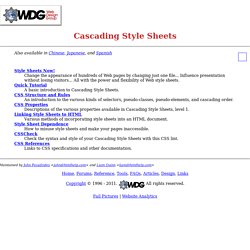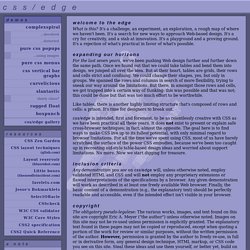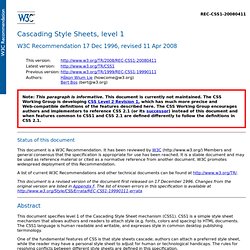

Dynamic Drive CSS Library- Practical CSS codes and examples. Eric Meyer: CSS. CSS Work Books by Eric Including Smashing CSS, CSS: The Definitive Guide, Third Edition, CSS Pocket Reference, and Cascading Style Sheets 2.0 Programmer’s Reference, among several others.

Articles by Eric Local copies of CSS articles, as well as other writing I've done. Inline model document A terse, but hopefully complete, description of how the CSS inline box model really works. Color equivalents table All 147 SVG-derived color keywords permitted in CSS3 in a sortable table showing the keywords with their equivalents in both hexadecimal notations, both (non-alpha) RGB notations, and non-alpha HSL.
CSS Module Timelines A visualization of the activity of the CSS Working Group by plotting draft publication dates and W3C statuses over time. CSS Module Editors Leaderboard A bit of a goof wherein I score the editors of various CSS modules and present the results as a leaderboard. CSS Tests A fairly large collection of test files I’ve accumulated over the years. W3C CSS2 Test Suite Prototyping Offsite. MaKo 4 CSS - CSShark's Tutorial on CSS and CSS-P. CSS Tutorial. Guide to Cascading Style Sheets. Also available in Chinese, Japanese, and Spanish Style Sheets Now!

Change the appearance of hundreds of Web pages by changing just one file... Influence presentation without losing visitors... All with the power and flexibility of Web style sheets. Quick Tutorial A basic introduction to Cascading Style Sheets. CSS Structure and Rules An introduction to the various kinds of selectors, pseudo-classes, pseudo-elements, and cascading order. CSS Properties Descriptions of the various properties available in Cascading Style Sheets, level 1. Linking Style Sheets to HTML. Css/edge. Please note that none of the demonstrations in css/edge are intended to work in Navigator 4.x.

I say this not to denigrate that browser, but instead to spare you any frustration you might otherwise feel. This site exists to explore the cutting edge of HTML+CSS design, and Navigator 4.x is, at four years and counting, just too old to keep up with most things that will be done here. Again, there's nothing wrong with Navigator 4.x, but you probably don't want to use it in this area. Consider it a friendly warning. Welcome to the edge What is this?
Expanding our horizons For the last seven years, we've been pushing Web design further and further down the same path. Like tables, there is another highly limiting structure that's composed of rows and cells: a prison. Css/edge is intended, first and foremost, to be as relentlessly creative with CSS as we have been practical all these years. Inclusion Criteria Copyright. Cascading Style Sheets, level 1. W3C Recommendation 17 Dec 1996, revised 11 Apr 2008 Note: This paragraph is informative.

This document is currently not maintained. The CSS Working Group is developing CSS Level 2 Revision 1, which has much more precise and Web-compatible definitions of the features described here. The CSS Working Group encourages authors and implementors to reference CSS 2.1 (or its successor) instead of this document and when features common to CSS1 and CSS 2.1 are defined differently to follow the definitions in CSS 2.1. Status of this document This document is a W3C Recommendation. A list of current W3C Recommendations and other technical documents can be found at This document is a revised version of the document first released on 17 December 1996.
Abstract This document specifies level 1 of the Cascading Style Sheet mechanism (CSS1). The W3C CSS Validation Service. Advanced CSS Layouts: Step by Step. Abstract The Challenge: Replicate WebRef's front page using CSS.

The Solution: CSS and lots of iterations. Rogelio Lizaolo improves on Kwon Ekstrom's CSS version of WebRef's tabled home page. Months in the making, the final design successfully duplicates WebRef's layout without the use of tables. Numerous bugs were discovered in Netscape and Internet Explorer in how they handle CSS, and we found some elegant workarounds to these and other problems. Introduction In "Evolution of a Home Page" Andy King threw down the gauntlet, challenging readers to duplicate WebRef's tabled (and fabled) home page in CSS.
The ultimate goal is to create a CSS layout that exactly resembles the WebReference.com layout made with tables and also behaves well with small window sizes and large fonts. The target browsers are all the generation five and greater browsers, for both Windows and Macintosh platforms. The Layout Challenge Can this complex layout be replicated using only CSS?
3 Column Layout: Step by Step.